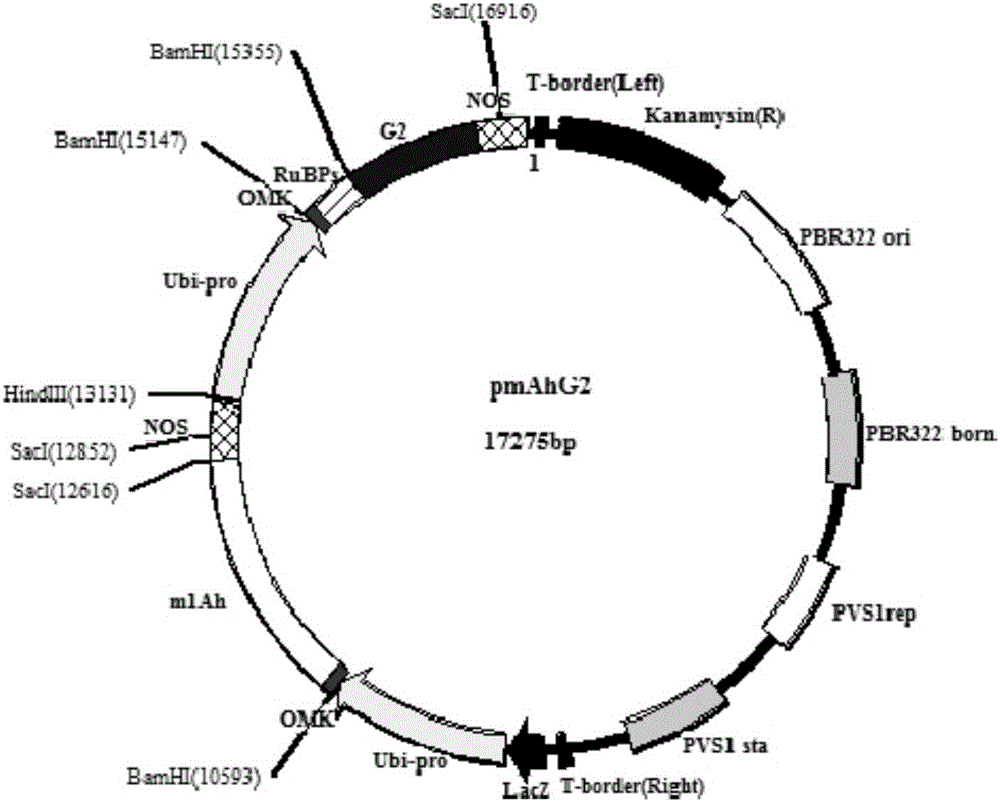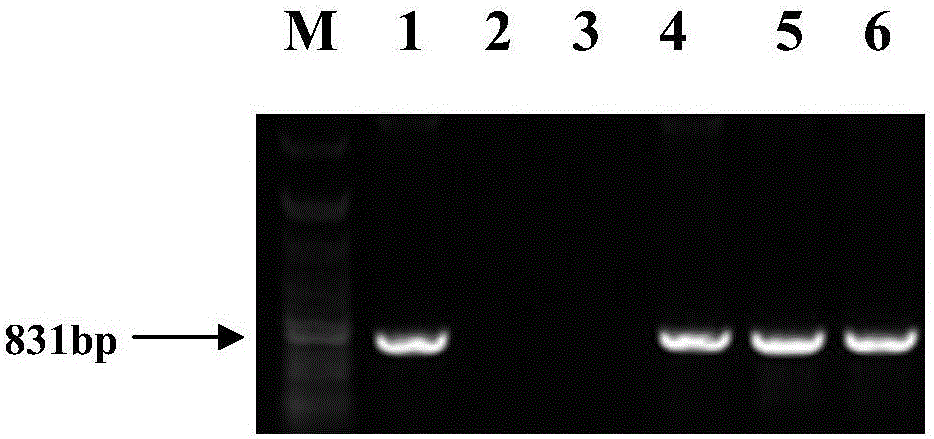Flanking sequence of genetically modified insecticidal maize HKG60 exogenous insert fragment and detecting method of flanking sequence
A technology of genetically modified corn and insect-resistant corn, applied in biochemical equipment and methods, microbial determination/inspection, DNA/RNA fragments, etc.
- Summary
- Abstract
- Description
- Claims
- Application Information
AI Technical Summary
Problems solved by technology
Method used
Image
Examples
Embodiment 1
[0046] Example 1, the acquisition of transgenic corn event HGK60
[0047] 1. Construction of plant expression vectors for maize transformation
[0048] The plant expression vector used in this study is pmAhG2 (preserved at the Institute of Biotechnology, Chinese Academy of Agricultural Sciences), see figure 1 . The backbone of the plant expression vector is pCAMBIA3300, and the ubiquitin promoter from maize ubiquitin protein, the transformed Btcry1Ah gene (patent number: ZL200410009918.9, see SEQ ID NO: 3) and the NOS terminator are inserted into the multi-cloning of the vector, and the screening of the insertion is performed at the same time The marker gene is the G2-aroA gene, and the G2-aroA gene is a glyphosate-tolerant strain isolated from long-term glyphosate-polluted soil—the encoded EPSPS enzyme ( Patent No.: ZL03826892.2), the G2-aroA gene is driven by the maize ubiquitin promoter, the terminator is NOS, the screening marker gene expression cassette is connected wit...
Embodiment 2
[0125] Example 2. Analysis of the foreign gene insertion site of the transgenic maize event HGK60
[0126] According to the analysis of the Southern blot results of the transgenic maize event HGK60: as image 3 There are three BamHI restriction sites in the inserted expression cassette, and when the 831bp Digoxigenin-labeled m4-cry1Ah gene fragment is used as probe 1 for hybridization, no matter the foreign fragment There are several copies inserted, all of which will be hybridized to obtain a fragment with a size of 4.6Kb ( Figure 4 ), the three samples showed the same hybridization band; there was one HindⅢ restriction site and three SacⅠ restriction sites in the inserted expression cassette, and these restriction sites were all located at the 3' end of the cry1Ah gene, which would not The identification of the copy number of the cry1Ah gene was affected, and the result was that both HindⅢ and SacⅠ digestion products hybridized with 2 bands ( Figure 4 ), which proved to ...
Embodiment 3
[0136] Example 3 Obtaining the 5' and 3' flanking sequences of the transgenic event HGK60 by chromosome walking
[0137] Foreign fragments inserted into the maize genome such as Figure 6As shown, two copies of the modified cry1Ah gene and the modified G2-aroA marker gene are inserted in series on the maize chromosome, because the ubiquitin promoter is derived from the maize ubiquitin gene, which is contained in the maize genome, so It is not easy to obtain the flanking sequence by chromosome walking method, so primers were designed starting from the G2-aroA gene and amplified from the 5' end to the 3' end of G2-aroA.
[0138] Specific primers were designed as follows:
[0139] SP1: TCCTCGCAGCCTTCAACAATACTCCC (on the G2-aroA gene)
[0140] SP2: GGTCTCAGGCATTCGCATTCAG (located on the G2-aroA gene)
[0141] SP3: AATCCTGTTGCCGGTCTTGCGATGA (on nos)
[0142] The Chromosome Walking Kit was purchased from TaKaRa Company (GenomeWalkingKit). There were 4 degenerate primers in the k...
PUM
 Login to View More
Login to View More Abstract
Description
Claims
Application Information
 Login to View More
Login to View More - R&D
- Intellectual Property
- Life Sciences
- Materials
- Tech Scout
- Unparalleled Data Quality
- Higher Quality Content
- 60% Fewer Hallucinations
Browse by: Latest US Patents, China's latest patents, Technical Efficacy Thesaurus, Application Domain, Technology Topic, Popular Technical Reports.
© 2025 PatSnap. All rights reserved.Legal|Privacy policy|Modern Slavery Act Transparency Statement|Sitemap|About US| Contact US: help@patsnap.com



